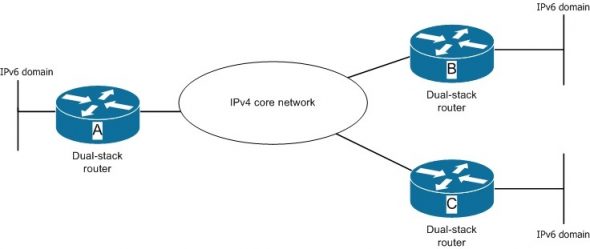An enterprise has implemented an IPv4 addressing scheme on the servers of its core network. To effectively handle the increasing user requests to the server, the enterprise has plans to implement three new subnets with IPv6 addressing in its existing IPv4 network. The network administrator has set up dual-stack routers on the boundary of these subnets, as shown in the network diagram.
You need to ensure interoperability between IPv4 and IPv6 hosts such that routers A, B, and C can dynamically determine the destination of an IPv6 packet. In addition, global unicast addresses should be supported on all hosts in the three IPv6 subnets.
Which of the following tunneling method can be used between the three routers? (Choose two.)
A. GRE tunnel
B. Automatic 6-to-4 tunnel
C. ISATAP tunnel
D. Manually-configured tunnel
Explanation:
You can use either automatic 6-to-4 tunnel or an Intra-site Automatic Tunnel Addressing Protocol (ISATAP) tunnel. Both of these tunneling methods are point-to-multipoint tunneling methods. This means that a single router (the point) can send IPv6 packets to different IPv6 routers (multipoints), depending on the destination address. When a router receives an IPv6 packet from an IPv6 host, it encapsulates the IPv6 packet in an IPv4 packet, which is then sent through the IPv4 core network. When the IPv4 packet is received at the destination router, the IPv6 address is extracted from the IPv4 packet and then forwarded to the intended IPv6 host.
Automatic 6-to-4 tunnels are created automatically by two IPv6 routers separated by an IPv4 network. These tunnels consider the IPv4 network as a virtual non-broadcast multi-access (NBMA) link. The tunnel is formed for every IPv6 packet that travels from one IPv6 border router to another IPv6 border router. IPv4 and IPv6 must be supported at both the border routers.
In automatic 6-to-4 tunneling, addresses belonging to the 2002::/16 prefix are used. In such IPv6 addresses, the 32-bit IPv4 address of each edge router is embedded into its IPv6 address increasing the length of the prefix to 48 (16 + 32). In automatic 6-to-4 tunnel, the IPv4 address of the router is embedded into the second the third quartet of the IPv6 address of the router.
ISATAP is also an automatic tunneling mechanism that uses an underlying IPv4 network as a NBMA link for IPv6 networks. However, it is most suitable for exchanging packets within an IPv6 network instead of exchanging packets between two IPv6 networks. With ISATAP tunnels, IPv6 dual-stack routers connected through the same IPv4 network can communicate with one another.
ISATAP works with unicast IPv6 addresses that are identified by a 64-bit prefix. The lowermost 64 bits are used to identify the interface of the router and are in modified EUI-64 format. The 0:5eFe value exists in the first 32 bits of the interface identifier. This value indicates that the IPv6 address is an ISATAP address. The remaining 32 bits contain the hexadecimal value of the IPv4 address; that is, the seventh and the eighth quartets in the IPv6 contain the IPv4 address.
You should not use a GRE tunnel or a manually configured tunnel between the three routers. These two tunneling methods provide static point-to-point tunnel between two IPv6 routers through an IPv4 network. Both these tunneling methods assume a virtual point-to-point link.
Objective:
Network Principles
Sub-Objective:
Recognize proposed changes to the network
References:
Cisco IPv6 Implementation Guide; Implementing Tunneling for IPv6


